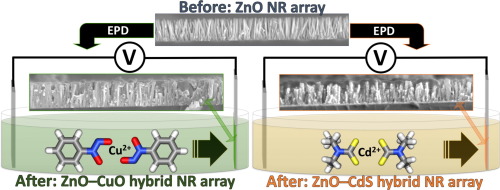Journal of Colloid and Interface Science ( IF 9.9 ) Pub Date : 2018-01-09 , DOI: 10.1016/j.jcis.2018.01.030 Michael Volokh , Mahmud Diab , Kobi Flomin , Taleb Mokari

|
Hypothesis
Subjecting colloids to electric fields often results in (electrophoretic) deposition on conductive substrates. Dispersing a single-source precursor (SSP) of choice in an appropriate solvent, should allow its deposition on different substrates. The SSP-solvent interaction might play a role in the deposition (e.g., direction, rate, coverage). After thermal decomposition, the SSPs convert to the designed material, thus allowing formation of thin films or hybrid nanostructures.
Experiments
Electrophoretic deposition (EPD) was applied on two representative SSPs in different solvents. These SSPs were deposited onto substrates covered with vertically-aligned ZnO nanorod (NR) arrays. After thermal decomposition, hybrid nanostructures were obtained and their morphology and interfaces were characterized by electron microscopy, X-ray diffraction, UV–vis, and electrochemistry.
Findings
Tuning the organic dispersant-SSP interaction allows control over the final film morphology, which can result in coating and filling of NRs with metal-sulfides or metal-oxides after thermal decomposition of the SSP. These findings introduce a new facile method for a fast and large-scale uniform deposition of different (nanostructured) thin film semiconductors on a variety of substrates. We discuss the influence of the dispersant medium on the deposition of metallo-organic SSPs. As an example, the formed ZnO–CdS interface supports charge transfer upon illumination.
中文翻译:

电泳沉积单源前驱物作为形成混合纳米棒阵列异质结构的一般方法
假设
使胶体受到电场作用通常会导致(电泳)沉积在导电基材上。将所选的单源前驱物(SSP)分散在适当的溶剂中,应使其沉积在不同的基材上。SSP与溶剂的相互作用可能在沉积过程中发挥作用(例如,方向,速率,覆盖率)。热分解后,SSP转换为设计的材料,从而允许形成薄膜或杂化纳米结构。
实验
电泳沉积(EPD)应用于两种不同溶剂中的代表性SSP。这些SSP沉积在覆盖有垂直排列的ZnO纳米棒(NR)阵列的基板上。热分解后,获得了杂化的纳米结构,并通过电子显微镜,X射线衍射,UV-vis和电化学对它们的形貌和界面进行了表征。
发现
调节有机分散剂与SSP的相互作用可以控制最终的膜形态,这可能导致在SSP热分解后用金属硫化物或金属氧化物涂覆和填充NR。这些发现为在各种基板上快速且大规模地均匀沉积不同(纳米结构)薄膜半导体提供了一种新的简便方法。我们讨论了分散介质对金属有机SSP沉积的影响。例如,形成的ZnO–CdS界面在照明时支持电荷转移。


























 京公网安备 11010802027423号
京公网安备 11010802027423号